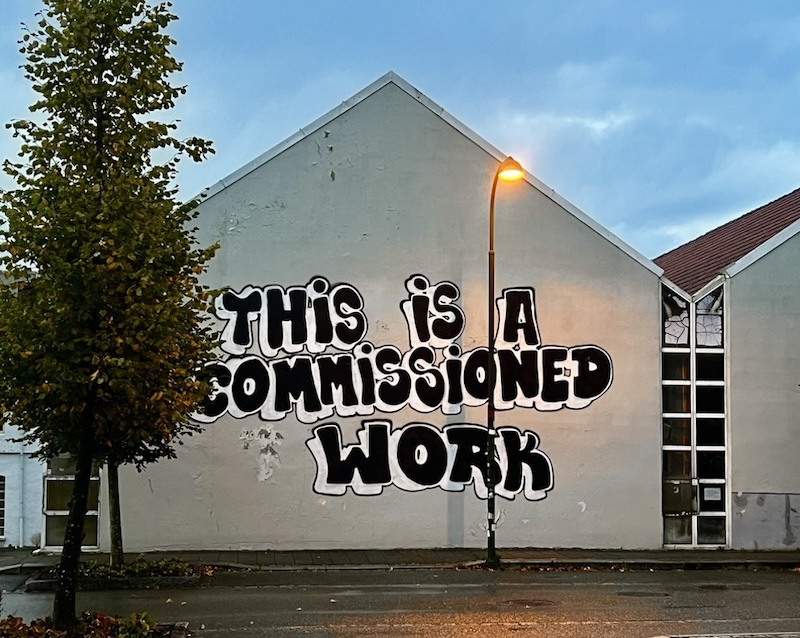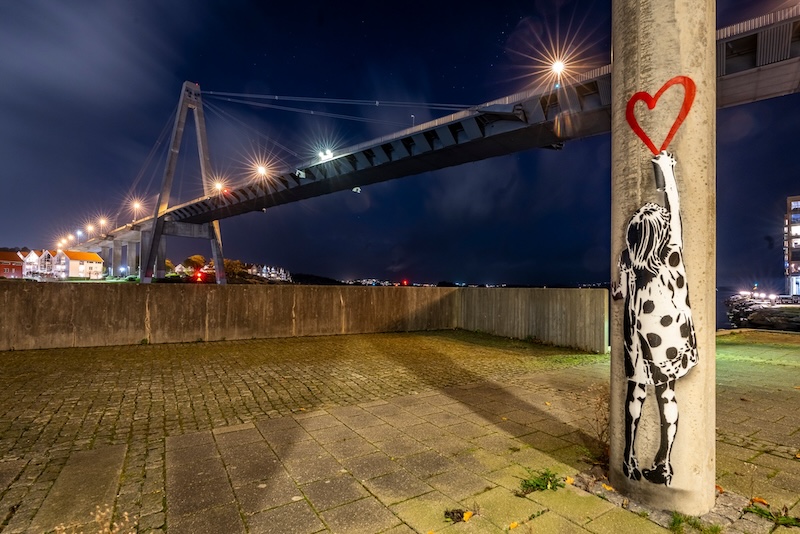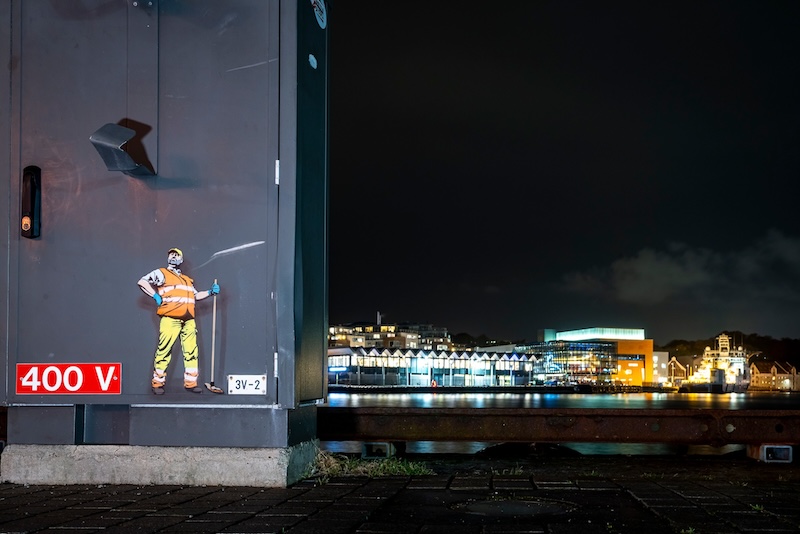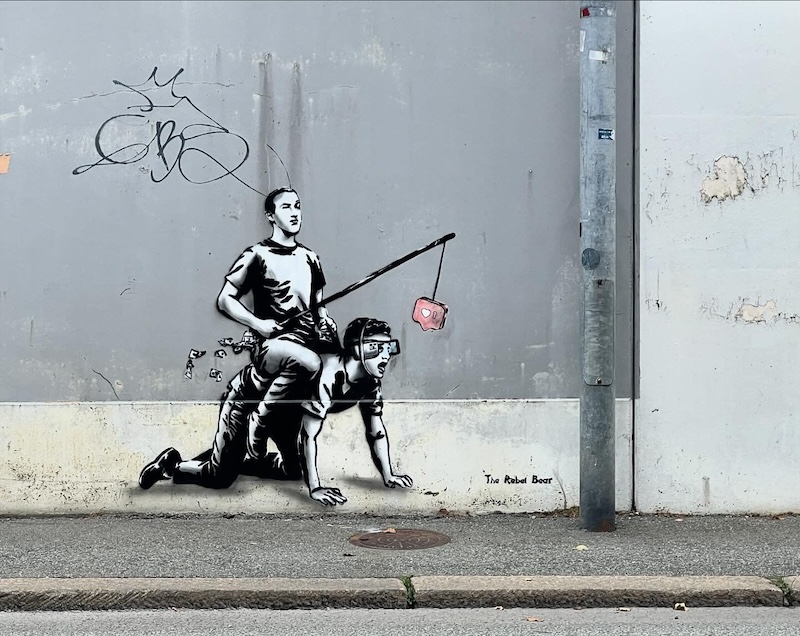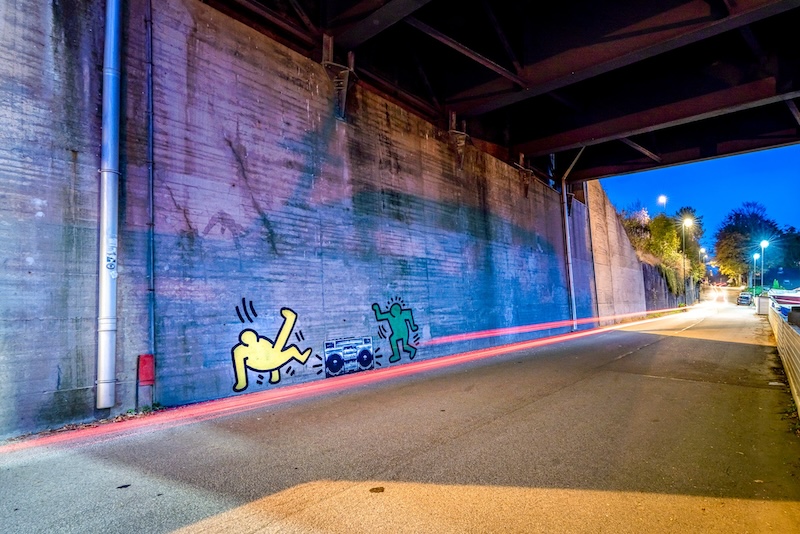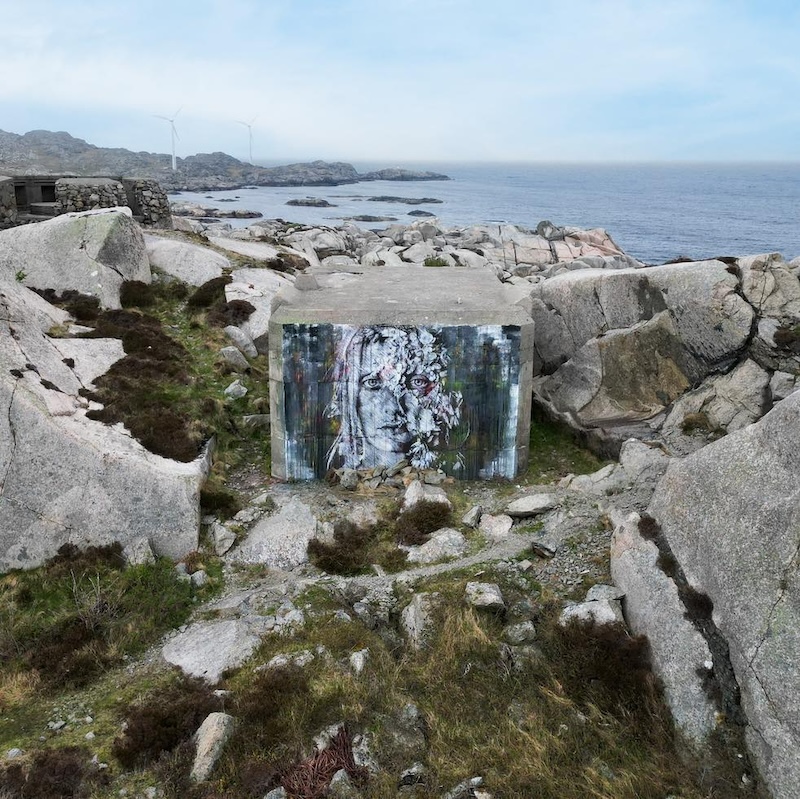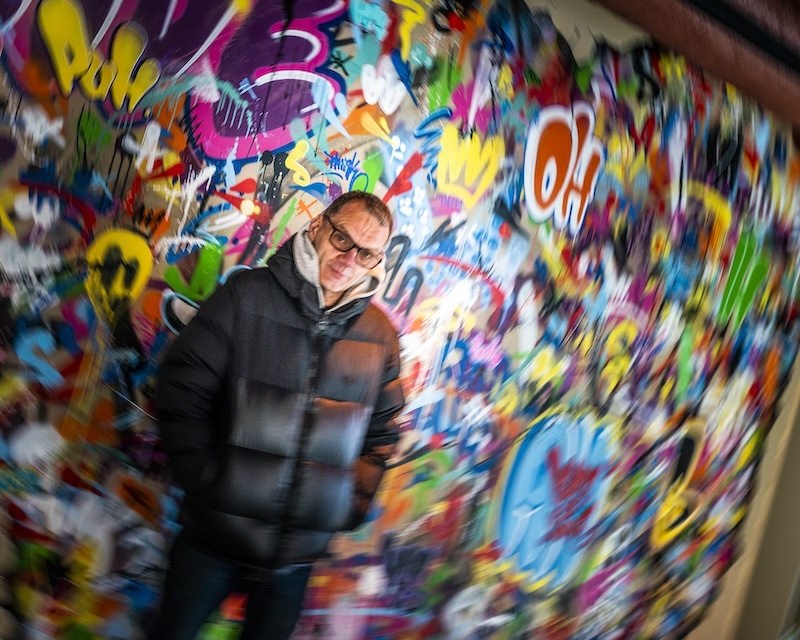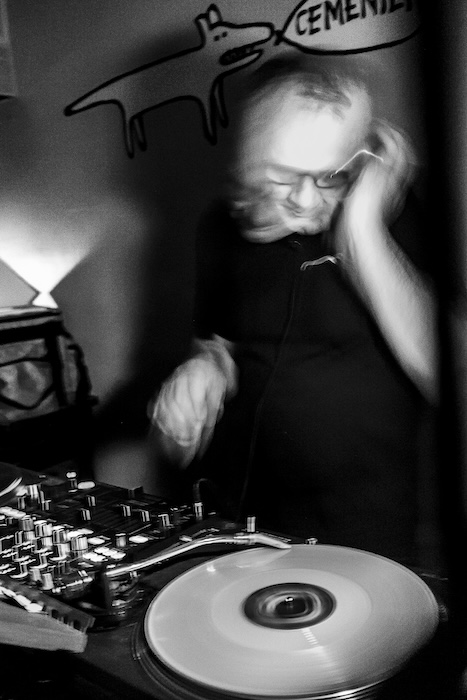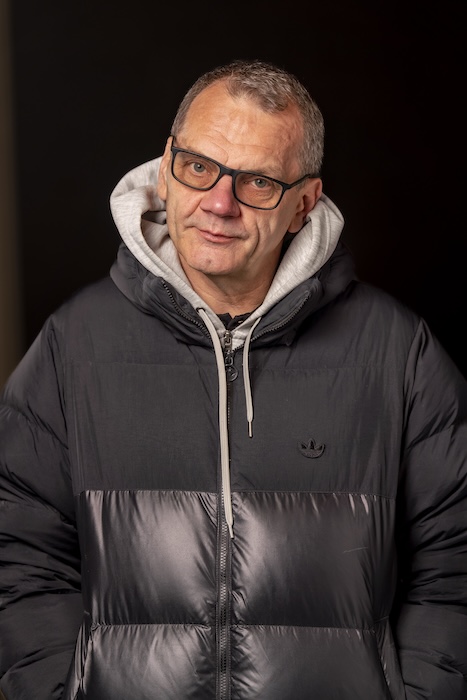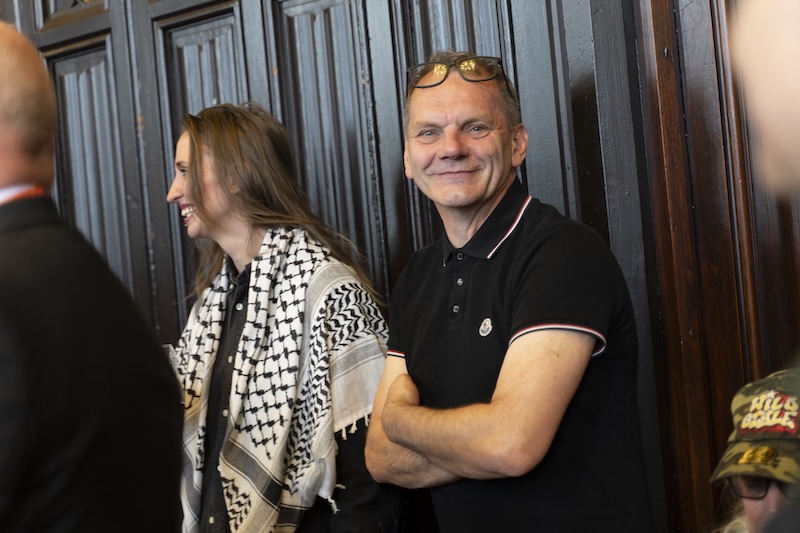Martyn Reed is a trailblazing curator in the street art world and the founder of Nuart Festival—the world’s first street art festival—launched in Stavanger, Norway, in 2001. With Nuart, Martyn has championed reclaiming public space and making art accessible beyond traditional gallery walls. In 2017, he brought Nuart to Aberdeen, Scotland, extending his vision to a new setting while continuing to challenge conventional approaches to urban art.
This fall, Martyn Reed’s Nuart Festival returned to the streets of Stavanger after a multi-year hiatus, embracing a “back to basics” format that reclaims street art as a tool for exploring and reimagining public space.
Stripping away the “over-structure” typical of street art festivals—a format he himself pioneered in the 2000s—Martyn has brought Nuart back to the authenticity of 20 years ago. This time, the festival focuses on one artist at a time, with an “artist residency” model spanning three months instead of hosting many artists in the same city over a one-week period.
I’ve been deeply struck by the works created so far and by the spirit of this “new” Nuart Festival, which, in reality, isn’t new at all. Martyn has simply returned to the roots of what he did in the beginning, before his format grew into a global phenomenon—one that, over time, has often been co-opted by institutions and repurposed as a sanitized tool for urban renewal and gentrification.
With this fresh edition of Nuart, Martyn is once again breaking new ground, leading a return to the culture’s roots and showing the world that street art can still be a grassroots force. He’s proving that artists can reclaim urban spaces from the grip of commercialization and institutional control.
A typical festival edition would usually bring 12 to 16 new murals to Stavanger’s streets. But the “Unauthorised” edition has far exceeded that, with 118 individual works created across the city so far—116 of them done without permission, and only 2 buffed—and artists are still arriving.
The recent works in Stavanger—and especially the way they’ve been created, unsanctioned and 100% spontaneous, taking Banksy’s approach of “asking for forgiveness, not for permission”—remind us that the heart of street art is still beating strong.
It also reminded me that I still hadn’t shared a thought-provoking conversation we had at Nuart Aberdeen back in 2023. In that chat, Martyn touched on ideas and budding concepts that have since blossomed into the Nuart Festival we see today. Even then, you could glimpse the seeds of the revolution he’s now bringing forward:
“It’s rare for other festivals to invite poster artists or people who do paste-ups, stickers, and small-scale stuff. For me, though, a sticker can be as meaningful as a mural. Actually, to be honest, the most powerful, interesting work for me is often the messiest, least polished stuff—and I know that sounds counterintuitive. But here’s the thing: nobody looks at a big mural and thinks, ‘Wow, I’m going to go home and try that myself.’ You just stand there in awe, like watching a firework display. It’s impressive, sure, but it creates a passive experience for the viewer. On the other hand, when you see a rough little stencil that says something like ‘smash the system’ or some message about love, it hits differently. That’s the kind of thing that makes people want to try it themselves. You get butchers, bakers, oil workers—whoever—going home, sitting down at the kitchen table with their kids, and making their own stencils. And we should never underestimate how hard it is to break down that barrier to making art, or how much that simple act rewires your brain.”
Martyn Reed
At the time of that conversation, the Norwegian edition of Nuart was on hold. Martyn had encountered some political challenges with the city council and decided to step back from working with them. However, he continued to organize occasional interventions over the years, such as the remarkable pieces he created with Nuno Viegas and SNIK, already embracing the mindset of “asking forgiveness, not permission.”
“I’m not doing this just to push the wrong buttons. I do it because I think it’s the right thing to do at the right time. And it’s not for the council, and it’s not for me—it’s for the artists and the public. We’re kind of the middlemen here. Sometimes you have to take a bit of shit for that and be willing to stand up for what’s right. When they say, ‘No, you can’t do it here, maybe over there,’ I’m like, well, that’s not the foundation of our practice.”
Martyn Reed
So, how did Martyn shape a festival that honored the core values of the practice? Let’s take it back to where it all began…
Laying the Groundwork for Nuart Festival
“The first time I went to Stavanger was in 1995. I’d been invited to DJ by a friend of my girlfriend at the time, who was Norwegian. I was living in London back then, fresh out of art school—Hornsey College of Art, which was quite the hotbed for radical ideas.”
Martyn Reed
Martyn graduated from Hornsey College of Art, a London institution known as a hub for radical ideas, in the early 1990s. It was the height of the Young British Artists (YBA) movement, a time when pursuing a career in art felt suddenly possible—no longer strictly reserved for the middle class or posthumous recognition. Soon after, he founded an art collective called PHASED, exploring new media and the internet as an uncharted, placeless frontier.
“We had this art group that blended club culture—running clubs, techno music—and the idea of the internet as a kind of ‘non-space’ where you could work without gatekeepers. (The technical term would be a T.A.Z., a Totally Autonomous Zone). It showed up in our DJing and club visuals, which might have just looked like pretty pictures if you were on the dance floor, but there was a lot of thought behind it. We were into critical theory. Then we got invited to Norway by a friend of my girlfriend at the time, who was running a club and was heavily involved in the arts. They wanted to host a sort of millennial festival in ‘95—five years before the millennium—to explore what we thought might be coming in the future.”
Martyn Reed
It was the era of Y2K, when people feared that the entire internet might collapse at the turn of the millennium—that every clock and computer would reset, and the world would have to start over. The four members of the collective headed to Stavanger, where they performed and made their mark on the city. In fact, they didn’t just DJ; they also experimented with stencils—before stencils were even popular. They transformed the cityscape, even casting a purple glow over the main high street’s lighting, fully embracing the city as their creative playground.
“And then I saw Stavanger. At the time, it was the wealthiest city in the wealthiest country in the Western Hemisphere—zero unemployment, and solid arts funding. But it was emerging from this really conservative culture, and people were curious, eager to see what else was out there. It was a generation with resources and no idea where to channel them. Most people would’ve looked around and thought, ‘There’s nothing here; I’m going back to London.’ But I saw this massive blank canvas. They didn’t have subcultures like we did in London, Paris, or New York, so to me, it was an open invitation to shake things up in the city.”
Martyn Reed
The Birth of Nuart Festival
On this blank canvas where anything felt possible, Nuart came to life in 2001. The festival began as a sister event to an electronic music festival that Martyn had been organizing since 1999, rooted in the same club culture that had shaped his early projects. Contemporary artists provided the visuals for these events, all deeply influenced by radical theory—a blend of resistance, empathy, and love. Martyn recognized this same spirit in the emerging world of street art, sensing its potential before it fully took shape.
“Arts Council-funded programs were all about advancing your career within a pretty narrow set of boundaries and criteria. Then I came across this new form of art, free from gatekeepers—art back on the streets, using the tactics and strategies of graffiti. Suddenly, there was this freedom to create what you wanted, where you wanted, in a way the public could actually connect with. It wasn’t this closed system of symbols that kept people out; it was about sharing what you knew and believed in with those who hadn’t had the privilege of an art education. That was around the time I first saw Banksy’s work, and I thought, wow, these artists are doing with a Stanley knife and a piece of cardboard—maybe €5 worth of materials—what we were trying to do with €10,000. And they were reaching more people, covering more ground. For me, it was never about the medium. It was always about the message and finding the best way to get that out there. And while we were stuck in this bureaucratic, admin-heavy art world with all its gatekeepers, these artists were out there covering entire cities with stencils, reaching way more people than we ever could.”
Martyn Reed
The chance to reach a broader audience in a more impactful, direct way pushed Martyn to make the leap from digital art to street art, despite everyone around him saying, ‘You’re crazy, you know?’ Undeterred, he submitted a proposal to the Arts Council, explaining his shift to street art. He referenced pioneers like John Fekner, Gordon Matta-Clark, and Jenny Holzer, tracing how this movement had evolved since the 80s. They worked to frame street art in a way the Arts Council would recognize, wrapping it in academic language to make it resonate.
“And they just tossed our application in the bin and pulled all our funding. That was the end of the first version of Nuart. So I went to the bank, got a loan, and since I’d already booked the artists, I went ahead with it anyway. The public response was incredible—people were like, ‘Oh my God, what is this new thing?’ And once the public got on board, politicians followed, like supporting the local football team. I think they gave us about $800 for that first event, and it just grew from there. I’m still paying off that loan, to be honest. But that was the real beginning of Nuart’s journey with street art.”
Martyn Reed
The first wave of artists invited to Nuart were deeply connected to the subvertising movement, a form of creative activism that involves ‘hijacking’ advertisements to expose or challenge consumer culture and corporate messaging. These artists engaged in practices like adbusting—altering or defacing advertisements to question or mock the brands behind them. They drew on situationism, a movement born in the 1950s that aimed to disrupt the status quo by turning everyday spaces into platforms for radical art, with a particular focus on breaking down the boundaries between art and life. One of their key methods was détournement, or ‘rerouting’—repurposing existing images and symbols to create something entirely new that subverts its original meaning. This spirit of creative rebellion set the tone for the first Nuart festivals, where artists used public spaces to make bold statements, challenging viewers to see the familiar in unfamiliar ways.
“It wasn’t really about big names in street art back then. Some of the artists were still just getting started. The first recognizable street art name—I can’t even remember who it was, to be honest. We had a mix of new media artists, like the guys from Graffiti Research Lab, who were some of the first to bridge graffiti with tech. Dotmaster was another one; he had a fine art background. With these early stencil artists, sometimes we were projecting their message as a moving matrix on the nightclub walls. There was a lot of crossover, with low-tech stencils on one side and coders writing software for DJ sets on the other. By 2005, we made the leap and went fully into street art. That year we brought over D*Face and… oh God, I can’t remember who else!”
Martyn Reed
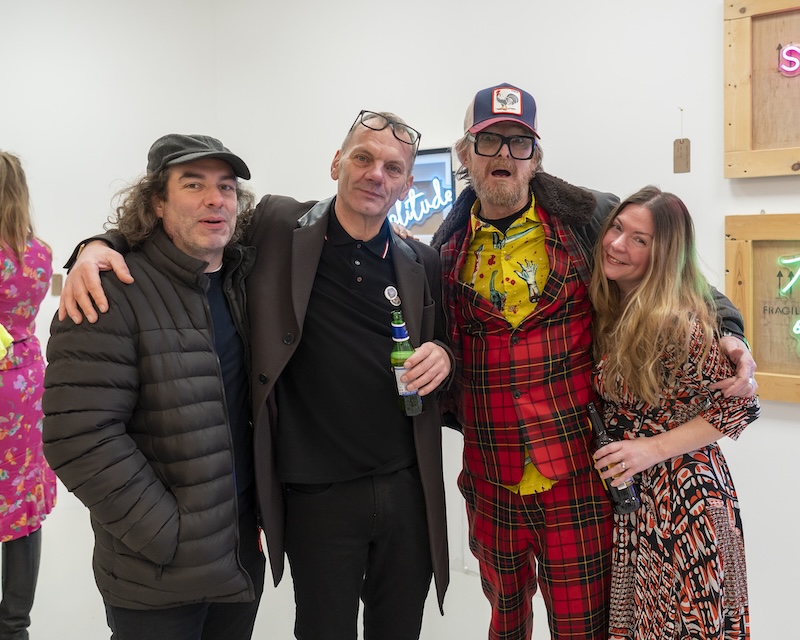
Photo by Brian Tallman.
The Art of “Uncurating” Nuart Festival
Martyn’s approach to selecting artists for the Nuart festival is natural and unplanned. Sometimes he has a theme in mind, other times he simply dives into a topic he’s currently obsessed about and finds artists whose work resonates with it. He reaches out whenever something genuinely grabs his attention, and often, one artist will lead him to the next. It’s a process that feels more like following a trail of creative sparks than any formal strategy.
“When one artist says yes, that often leads to the next. It’s like, okay, how do we connect this? What’s missing? Are we reaching the people we want to? We talk about curatorial decisions, but it’s not really like that. It’s more about organizing all the information out there and seeing if we can pose a question with it. The festival’s always asking questions; there’s never a final answer. That’s why we have our ‘Fight Club’”
Martyn Reed
I’d say that Martyn’s curatorial process is to a typical curatorial work what Nuart’s Fight Club—a kind of pub debate inspired by the original Greek Symposia, where ideas flowed freely over wine and a hot topic in street art culture is debated by artists, academics, and arts professionals in two opposing teams—is to traditional art conferences.
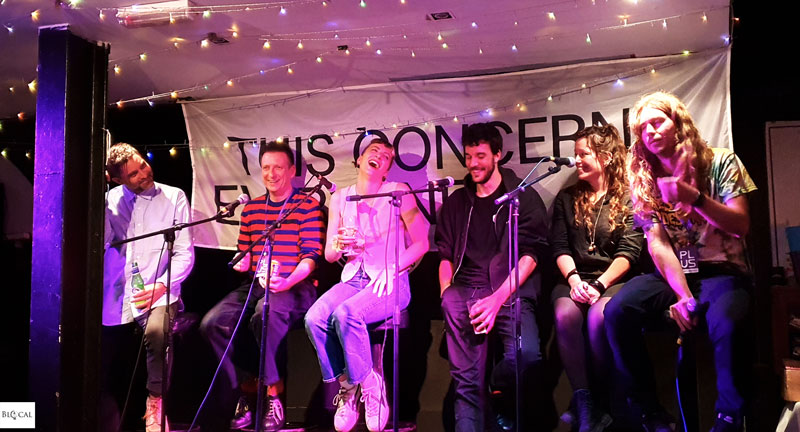
Over the years, I’ve often affectionately referred to Martyn as Nuart Festival’s “uncurator”—not to diminish his work, of course, but to emphasize that his role is more like that of a chef, carefully selecting the right ingredients and creating the perfect conditions for them to blend together in the best possible way.
“Honestly, I don’t really know how I ‘curate’ this. I only started using that word recently, but I still prefer saying we ‘organize’ it. Curation sounds like you’re directing or imposing something, and that’s not what we’re doing. Even with the spaces—after the main murals are done, the artists are free to roam and paint wherever they’re drawn. It’s less about curation and more like cultivating something, like a flower. And honestly, the problem with museums is they cultivate the wrong things; they go for the obvious stuff. They’re hanging around grad schools and grad shows, finding the neat little flowers to cultivate, which just makes more of the same. I’m way more interested in what’s outside of that—who’s getting overlooked at those shows for being too rough or not fitting in.”
Martyn Reed
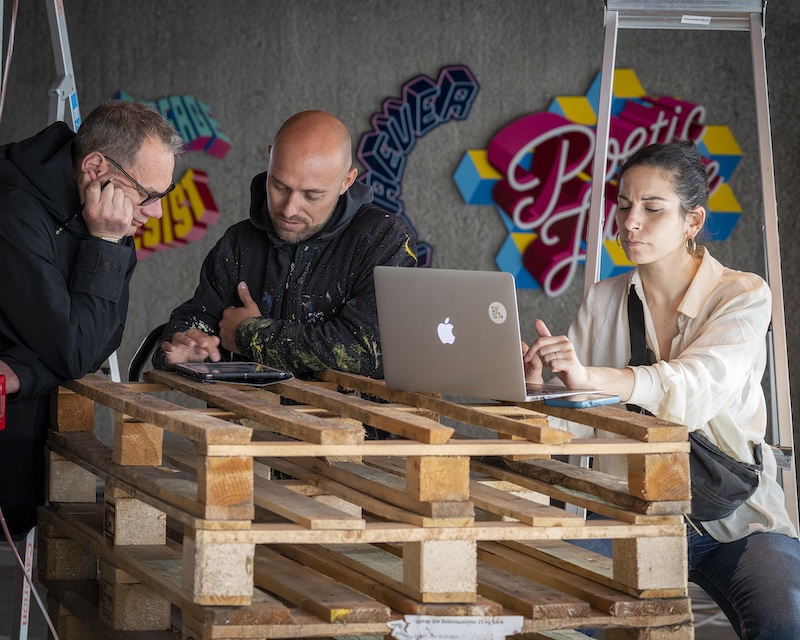
Photo by Brian Tallman.
Doing something against what we’ve been taught, giving ourselves permission to create without needing it to be polished or ‘acceptable’—that’s where the real power lies. A rough stencil on the street, a quickly sprayed message, is often far more genuine than an eye-catching mural. The stencil isn’t about impressing people; it’s about expressing a subculture, often delivering a message that challenges the status quo. It’s raw, it’s direct, and it speaks to something real. That’s what makes it powerful—the act of putting out a message that might be political, rebellious, or deeply personal, without worrying about it being neat or beautiful. It’s not about the glossy outcome but about reaching people in a way that feels authentic, rough edges and all.
“The most important work we’ve done is what someone once called ‘some crap stencil on the streets of Stavanger,’ and that stencil meant a lot to me. I’ve seen others try to copy it over and over—it’s been a real inspiration, and that’s exactly where we need to be. It’s the same with paste-ups: if you’ve got a piece of paper and some glue, you can take part in shaping public space. And that space, in turn, shapes your kids, your kids’ kids, and everyone who passes by. That’s the real power of it.”
Martyn Reed
These kinds of engaged reactions are what really interest Martyn—what he aims to “cultivate,” more than the artwork itself. His approach is about inspiring artists to bring life to the overlooked places: the forgotten corners, back alleys, and gritty streets. In a way, this goes against traditional graffiti culture, where artists typically seek out prime spots with maximum visibility.
“There’s so much power in a human-scale piece tucked away in a backstreet. Imagine you’re walking home drunk after a breakup, holding your kebab, and suddenly you come across it. That kind of personal encounter with the work, to me, is way more powerful than just passing by a huge mural on a bus. I think street art festival curators are losing sight of that—they’re just going for the biggest mural in the biggest spot. But what’s the point of that? It’s too in-your-face. You’re not discovering it anymore; you’re not just stumbling upon it. Those human-scale pieces feel so much more… human. They spark different reactions. Anything bigger than you has power over you—like a massive McDonald’s sign or a towering building. These things aren’t neutral; they make you feel small. The bigger the billboard, the smaller you feel. So, to me, the real soul of the culture is in those human-scale works. That’s not to say big murals shouldn’t exist—they should. But there needs to be a balance.”
Martyn Reed
The ‘power’ Martyn refers to isn’t the kind wielded by an over-imposing mural but the spark of curiosity ignited by the artworks he “cultivated” in Stavanger back in the early 2000s, when the entire street art movement was new—not only to Stavanger but to the world. Nuart was, in fact, the very first street art festival. Yet, as often happens, locals eventually began to take it for granted. When some of the world’s most remarkable murals are right on your doorstep, they start to blend into the background, becoming something you hardly notice. Few residents realize they’re surrounded by one of the world’s most extraordinary public art collections.
With this new edition of Nuart Festival, Martyn is reminding the street art world that those ‘magic sparkles’ can still be reignited. But to do that, you have to look back to the origins, to the raw authenticity that sparked it all, stepping away from what people have come to expect. Martyn is proving that street art can still provoke, challenge power, open doors, and invite the community to reclaim their city.
At the core of this vision lies Henri Lefebvre’s ‘right to the city’—the belief that urban spaces belong to the people who live in them. This philosophy of inclusivity, agency, and reclaiming space from commercial interests beats at the heart of Martyn’s work. Through Nuart, he’s rekindling street art’s original spirit, showing that even now, art can transform public space into a place of shared meaning, a space where the ordinary meets the extraordinary, and where the city, once again, belongs to everyone.
A heartfelt thank you to Martyn for sharing his words and wisdom—especially since he rarely gives interviews, making this insight all the more unique and special. And a big thank you to Nuart Festival’s official photographer, Brian Tallman, for his beautiful, thoughtfully captured photos of Martyn.
